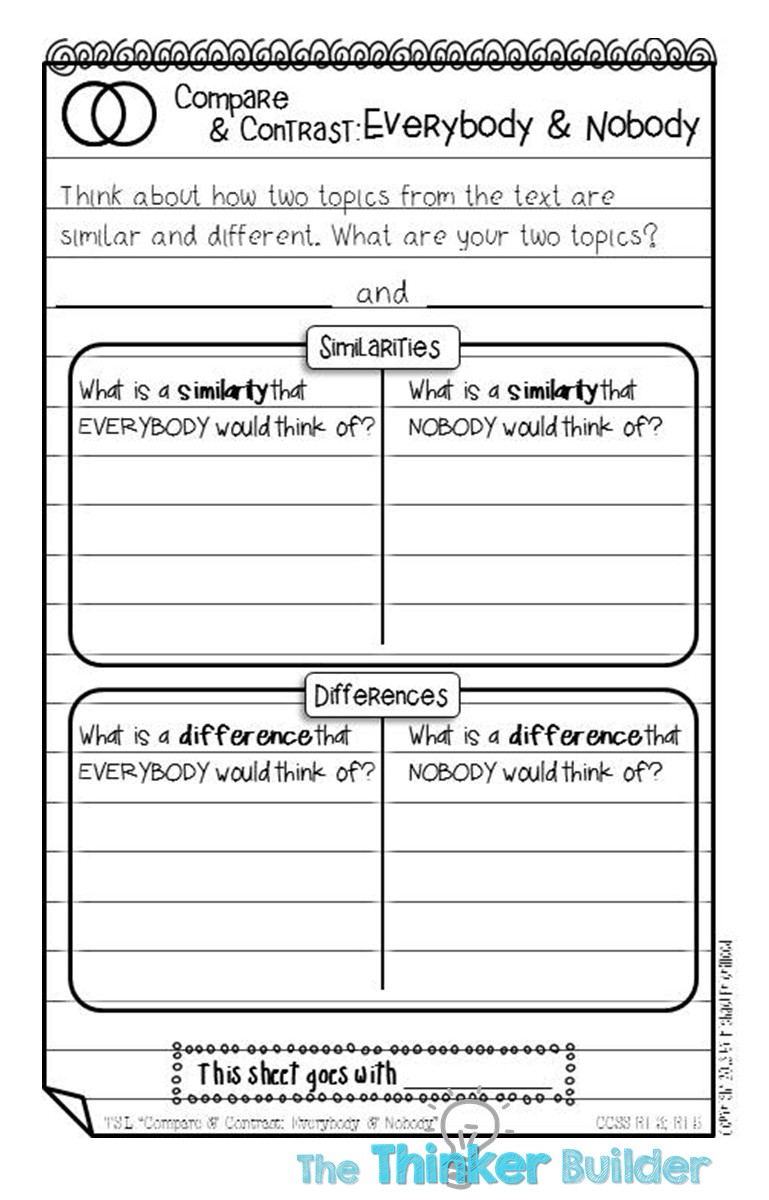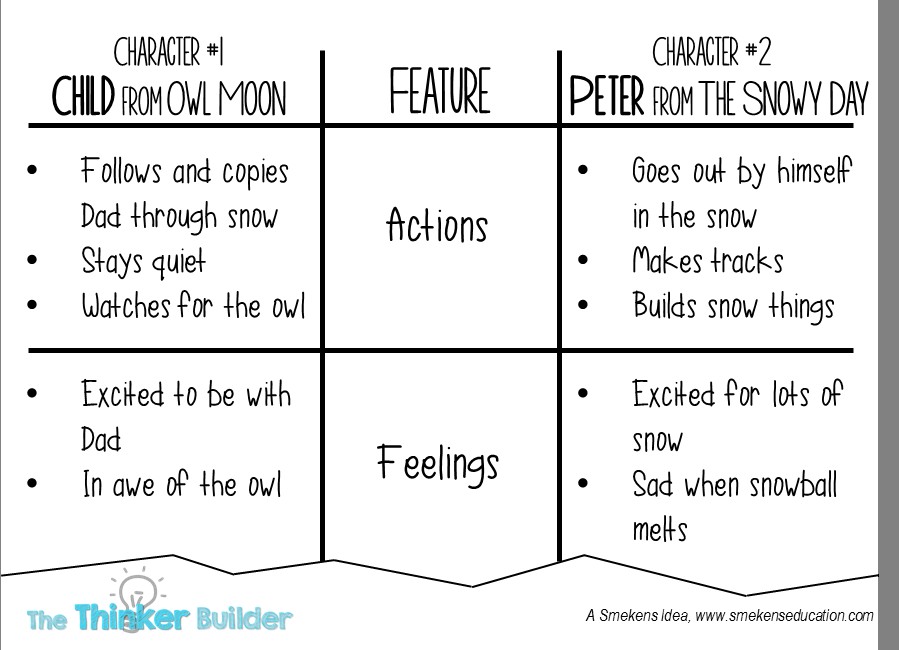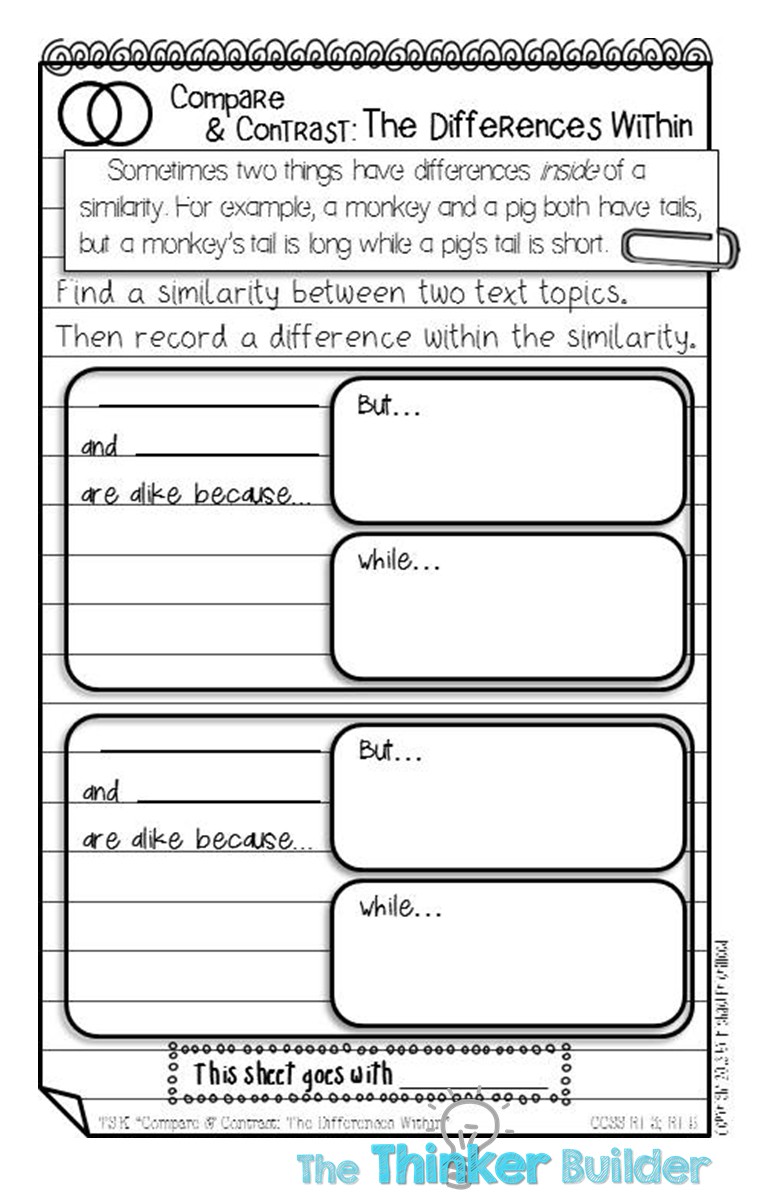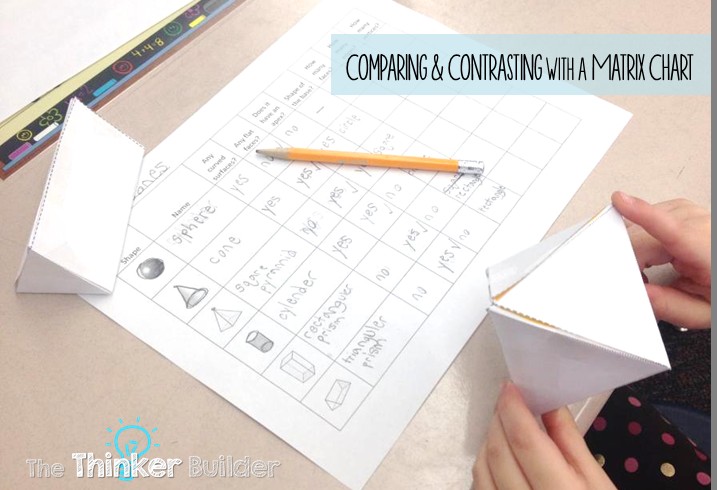Compare Contrast Venn Diagram techniques are a staple for analyzing similarities and differences. COMPARE.EDU.VN offers varied methods beyond traditional Venn diagrams to enhance analytical skills. By exploring these alternative strategies, you can discover more effective ways to dissect information and foster deeper understanding.
1. Understanding the Compare Contrast Venn Diagram
The compare contrast Venn diagram is a visual tool that uses overlapping circles to illustrate the similarities and differences between two or more subjects. It’s a classic method, but sometimes it may not be the most effective for everyone. Let’s delve into why that is.
1.1. What Is a Compare Contrast Venn Diagram?
A compare contrast Venn diagram typically consists of two or three overlapping circles. Each circle represents a different subject, and the overlapping sections represent the characteristics that those subjects share. The non-overlapping sections highlight the unique characteristics of each subject.
1.2. Why Use a Venn Diagram?
Venn diagrams are popular because they offer a clear, visual way to organize information. They can help you:
- Identify common traits
- Highlight unique differences
- Organize thoughts and ideas
- Improve comprehension
1.3. Limitations of Traditional Venn Diagrams
While Venn diagrams have their merits, they also come with limitations:
- Limited space: The overlapping sections can be too small for detailed notes.
- Organization issues: Keeping the outer areas organized can be challenging.
- Complexity: As you add more subjects, the diagram can become confusing.
- Lack of depth: Sometimes they only scratch the surface of deeper analysis.
2. Alternative Strategies to Compare and Contrast
If you find Venn diagrams limiting, don’t worry. There are several other strategies you can use to compare and contrast effectively. These alternatives can provide a fresh perspective and accommodate more detailed analysis.
2.1. The “Everybody and Nobody” Strategy
This strategy involves identifying similarities and differences that are obvious (“everybody” would think of them) and those that are less obvious (“nobody” would think of them). It’s a great way to encourage deeper thinking and differentiate instruction.
2.1.1. How It Works
- Choose two subjects: Select the items or concepts you want to compare.
- “Everybody” similarities: List similarities that are immediately apparent.
- “Everybody” differences: List differences that are easily noticeable.
- “Nobody” similarities: Identify less obvious, more nuanced similarities.
- “Nobody” differences: Find unique, less apparent differences.
2.1.2. Example
Let’s compare cats and dogs using the “Everybody and Nobody” strategy:
| Category | Cats | Dogs |
|---|---|---|
| Everybody | ||
| Similarities | Both are common pets | Both are common pets |
| Differences | Cats are independent | Dogs are loyal |
| Nobody | ||
| Similarities | Both can be trained with patience | Both can be trained with patience |
| Differences | Cats have retractable claws | Dogs have a stronger sense of smell |




2.1.3. Benefits
- Encourages deeper thinking
- Accommodates different skill levels
- Highlights obvious and subtle comparisons
2.2. T-Chart Strategy
T-charts are versatile tools for organizing information. This strategy uses a three-column chart to compare two topics based on specific features.
2.2.1. How It Works
- Draw a T-chart: Create a table with three columns.
- Label columns: Label the left and right columns with the topics you’re comparing. Label the middle column with the features you’ll focus on.
- Compare features: For each feature, describe how it relates to each topic.
2.2.2. Example
Let’s compare coffee and tea using a T-chart:
| Feature | Coffee | Tea |
|---|---|---|
| Caffeine | High | Moderate |
| Flavor | Bold and robust | Delicate and varied |
| Preparation | Brewed with coffee maker | Steeped in hot water |
| Health Benefit | Antioxidants, increased alertness | Antioxidants, relaxation benefits |
2.2.3. Benefits
- Simple and easy to use
- Versatile for various subjects
- Focuses on specific features
2.3. Analogies Method
Using analogies can help you make unexpected connections between subjects, pushing you to think creatively.
2.3.1. How It Works
- Choose a subject: Select an element or idea from your topic.
- Find an analogy: Compare it to something seemingly unrelated.
- Identify similarities: List ways the subject and analogy are similar.
- Identify differences: List ways the subject and analogy are different.
2.3.2. Example
Let’s compare a smartphone to a Swiss Army knife:
- Subject: Smartphone
- Analogy: Swiss Army knife
- Similarities: Versatile tools, multiple functions, portable
- Differences: Smartphones require power, Swiss Army knives are manual; smartphones are for communication, Swiss Army knives are for physical tasks.
2.3.3. Benefits
- Encourages creative thinking
- Helps make abstract concepts more concrete
- Offers a unique perspective
2.4. “The Differences Within” Strategy
This strategy focuses on identifying a common similarity between two topics and then exploring the differences within that similarity.
2.4.1. How It Works
- Identify a similarity: Find a common trait between the two topics.
- Explore differences: Within that similarity, identify specific differences.
- Organize information: Use a visual structure to represent the similarity and its internal differences.
2.4.2. Example
Let’s compare two types of exercise: running and swimming.
- Similarity: Both are forms of cardiovascular exercise.
- Differences:
- Running: High impact, weight-bearing, requires good shoes
- Swimming: Low impact, non-weight-bearing, requires a pool
2.4.3. Benefits
- Highlights nuanced differences
- Provides a structured approach to comparison
- Encourages deeper analysis
2.5. Matrix Chart Method
Matrix charts are perfect for comparing multiple items across various criteria. They provide a structured way to organize complex information.
2.5.1. How It Works
- Create a table: Set up a spreadsheet with rows for each item and columns for each comparison criterion.
- Fill in the chart: Complete each cell with the relevant information.
- Analyze the data: Look for patterns, similarities, and differences.
2.5.2. Example
Let’s compare three types of laptops:
| Feature | Laptop A | Laptop B | Laptop C |
|---|---|---|---|
| Price | $800 | $1200 | $1500 |
| Processor | Intel i5 | Intel i7 | Intel i9 |
| RAM | 8GB | 16GB | 32GB |
| Storage | 256GB SSD | 512GB SSD | 1TB SSD |
| Screen Size | 13 inch | 15 inch | 15 inch |
| Battery Life | 8 hours | 10 hours | 12 hours |
| Operating System | Windows 10 | Windows 10 | Windows 10 |
2.5.3. Benefits
- Ideal for comparing multiple items
- Organizes information in a clear, structured format
- Facilitates easy analysis
3. Real-World Applications of Comparison Techniques
Comparison techniques are essential in various fields, from education and business to personal decision-making. Understanding how to effectively compare and contrast can significantly enhance your analytical and decision-making skills.
3.1. Educational Settings
In education, comparison techniques are used to help students understand complex concepts, analyze literature, and evaluate historical events.
- Literature Analysis: Students can compare characters, themes, or plot structures in different novels.
- Historical Events: Comparing the causes and effects of different historical events helps students understand history more deeply.
- Scientific Concepts: Comparing different scientific theories or processes helps students grasp the nuances of science.
3.2. Business and Marketing
Businesses use comparison techniques to analyze competitors, understand market trends, and make strategic decisions.
- Competitor Analysis: Companies compare their products, services, and marketing strategies with those of their competitors to identify strengths and weaknesses.
- Market Research: Comparing different market segments helps businesses tailor their products and marketing efforts.
- Product Development: Comparing different product features helps companies design products that meet customer needs. According to a study by the University of California, Los Angeles (UCLA) in March 2024, detailed competitor analysis leads to a 15% increase in market share.
3.3. Personal Decision-Making
Comparison techniques are invaluable for making informed personal decisions, such as choosing a new car, selecting a college, or evaluating job offers.
- Choosing a Car: Comparing different car models based on price, fuel efficiency, safety features, and reliability helps you make the best choice.
- Selecting a College: Comparing different colleges based on academic programs, location, cost, and student life helps you find the right fit.
- Evaluating Job Offers: Comparing different job offers based on salary, benefits, work environment, and career growth opportunities helps you make a satisfying career decision.
4. Enhancing Your Comparison Skills
To become proficient in comparing and contrasting, practice is key. Here are some tips to help you hone your skills:
4.1. Practice Regularly
The more you practice, the better you’ll become at identifying similarities and differences. Try using these techniques in your daily life.
4.2. Be Organized
Use structured formats like charts and tables to organize your thoughts. This will help you see patterns and relationships more clearly.
4.3. Look for Nuances
Don’t just focus on the obvious. Dig deeper to find subtle similarities and differences that others might miss.
4.4. Use Reliable Sources
Ensure that the information you’re using is accurate and up-to-date. Consult multiple sources to get a comprehensive view.
4.5. Seek Feedback
Ask others to review your comparisons and provide feedback. This can help you identify areas where you can improve.
5. Leveraging COMPARE.EDU.VN for Informed Comparisons
At COMPARE.EDU.VN, we understand the importance of making informed decisions. That’s why we offer a range of resources to help you compare and contrast various options effectively.
5.1. Comprehensive Comparison Tools
Our website features comprehensive comparison tools that allow you to evaluate products, services, and ideas side-by-side. We provide detailed information, user reviews, and expert opinions to help you make the best choice.
5.2. User Reviews and Ratings
Benefit from the experiences of other users by reading their reviews and ratings. This can provide valuable insights and help you avoid potential pitfalls.
5.3. Expert Analysis
Our team of experts conducts thorough analysis and provides unbiased recommendations. We strive to offer accurate and reliable information to empower your decision-making process.
5.4. Visual Aids
We utilize visual aids such as charts, graphs, and diagrams to present complex information in an easily understandable format. This helps you quickly identify key similarities and differences.
5.5. Up-to-Date Information
We regularly update our information to ensure that you have access to the latest data. Stay informed about new products, services, and trends.
6. Case Studies: Successful Comparisons
Let’s explore a few case studies to illustrate how comparison techniques can lead to successful outcomes.
6.1. Case Study 1: Choosing the Right Smartphone
Challenge: A user needed to choose between three different smartphones but was overwhelmed by the options.
Solution: The user utilized a matrix chart to compare the phones based on key features such as price, camera quality, battery life, and storage capacity.
Outcome: By systematically comparing the options, the user was able to identify the smartphone that best met their needs and budget.
6.2. Case Study 2: Selecting a College
Challenge: A student had to choose between two colleges with similar academic programs.
Solution: The student used the “Everybody and Nobody” strategy to identify obvious and less obvious differences between the colleges. They considered factors such as campus culture, location, and financial aid opportunities.
Outcome: The student made an informed decision based on a comprehensive comparison, leading to a more satisfying college experience.
6.3. Case Study 3: Business Competitor Analysis
Challenge: A small business wanted to understand its position in the market relative to its competitors.
Solution: The business conducted a thorough competitor analysis using T-charts to compare products, services, and marketing strategies.
Outcome: The business identified its competitive advantages and developed strategies to differentiate itself in the market. According to a study by Harvard Business Review in January 2025, companies that perform regular competitor analysis experience a 20% growth in revenue.
7. Potential Pitfalls to Avoid
While comparison techniques can be incredibly useful, it’s important to be aware of potential pitfalls:
7.1. Confirmation Bias
Avoid seeking out information that only confirms your existing beliefs. Strive for objectivity and consider all perspectives.
7.2. Overemphasis on Minor Details
Focus on the most important criteria and avoid getting bogged down in minor details that don’t significantly impact your decision.
7.3. Incomplete Information
Ensure that you have all the necessary information before making a comparison. Missing data can lead to inaccurate conclusions.
7.4. Emotional Bias
Try to set aside your emotions and make decisions based on logic and reason.
7.5. Lack of Structure
Use structured formats to organize your thoughts and avoid making haphazard comparisons.
8. Frequently Asked Questions (FAQ)
Q1: What is a Venn diagram, and why is it used?
A1: A Venn diagram is a visual tool that uses overlapping circles to show similarities and differences between items. It’s used for organizing information and identifying common traits.
Q2: What are the limitations of using Venn diagrams for comparisons?
A2: Venn diagrams can have limited space for detailed notes, organization issues, and can become complex with multiple subjects, often lacking depth in analysis.
Q3: Can you explain the “Everybody and Nobody” strategy?
A3: The “Everybody and Nobody” strategy involves identifying similarities and differences that are obvious and those that are less obvious, encouraging deeper thinking.
Q4: How can T-charts be used for comparing and contrasting information?
A4: T-charts use a three-column chart to compare two topics based on specific features, making it versatile for various subjects.
Q5: What is the purpose of using analogies in comparison techniques?
A5: Using analogies helps make unexpected connections between subjects, pushing you to think creatively and offering a unique perspective.
Q6: What does “The Differences Within” strategy entail?
A6: “The Differences Within” strategy focuses on identifying a common similarity between two topics and then exploring the differences within that similarity.
Q7: When is it best to use a matrix chart for comparisons?
A7: Matrix charts are ideal for comparing multiple items across various criteria, providing a structured way to organize complex information.
Q8: How can COMPARE.EDU.VN help with making informed comparisons?
A8: COMPARE.EDU.VN offers comprehensive comparison tools, user reviews, expert analysis, visual aids, and up-to-date information to help you make informed decisions.
Q9: What are some potential pitfalls to avoid when comparing and contrasting?
A9: Potential pitfalls include confirmation bias, overemphasis on minor details, incomplete information, emotional bias, and a lack of structure.
Q10: Why is it important to practice comparison techniques regularly?
A10: Regular practice enhances analytical skills, helps in identifying subtle similarities and differences, and improves overall decision-making abilities.
9. Call to Action
Ready to make smarter, more informed decisions? Visit COMPARE.EDU.VN today and explore our comprehensive comparison tools. Whether you’re choosing a new product, evaluating job offers, or selecting a college, we have the resources you need to succeed. Our team of experts is dedicated to providing you with unbiased information and expert analysis. Don’t leave your important decisions to chance – trust COMPARE.EDU.VN to guide you every step of the way.
Contact us:
- Address: 333 Comparison Plaza, Choice City, CA 90210, United States
- WhatsApp: +1 (626) 555-9090
- Website: compare.edu.vn
Start comparing now and make decisions with confidence.